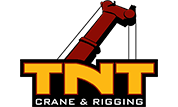Crane Safety Standards in Alberta
Crane Safety | Aug 26 / 25
Crane operations demand precision, experience, and, above all, safety. In Alberta, where industrial and construction projects often involve challenging and high-risk lifts, overlooking safety protocols can lead to severe consequences, from costly delays to serious injuries. At TNT Crane & Rigging, we know that staying compliant with Alberta’s safety regulations is not just about checking boxes; it is about actively preventing accidents and protecting every crew member and client we serve. That is why we’re highlighting the importance of understanding crane safety standards in Alberta to ensure every lift is carried out safely and efficiently.
Find out what should be included on your crane safety checklist.
Why Safety Standards Matter
Alberta has strict occupational health and safety (OHS) regulations, especially when it comes to crane operations. These rules are designed to prevent accidents, safeguard workers, and ensure all equipment is operated correctly. Companies that fail to follow these standards risk severe penalties and project delays.
Certification and Training Requirements
In Alberta, all crane operators must be certified in accordance with the OHS Code. This includes completing formal training, passing written exams, and gaining hands-on experience. Many operators hold Red Seal Journeyperson status and are also required to stay up to date through ongoing education and recertification.
Daily Equipment Inspections
Regular crane inspections are a must. Alberta regulations require daily visual inspections and more in-depth assessments at scheduled intervals. At TNT Crane & Rigging, we ensure every crane is inspected before deployment, and our operators conduct thorough checks each day on the jobsite to report and resolve any issues promptly.
Load Handling and Lift Planning
Proper planning is essential for safe crane operations. This involves assessing load weight, rigging techniques, ground conditions, and hoisting procedures. Many companies use load moment indicators as part of their standard equipment to provide real-time data during lifts, reducing the risk of accidents caused by excessive loads or tipping.
Fall Protection and Site Safety
Working with cranes often involves elevated positions and high-risk zones. Compliance with Alberta’s fall protection standards is mandatory, and all crew members must use appropriate safety gear. Site-specific hazard assessments, traffic control plans, and safety technologies support a safer work environment for both operators and ground personnel.
Equipment Standards and Maintenance
All cranes must meet the Canadian Standards Association (CSA) guidelines. At TNT Crane & Rigging, we go beyond minimum compliance by maintaining a modern fleet of crawler, mobile, and hydraulic cranes. Each unit undergoes regular service to meet and exceed CSA standards.
When you partner with TNT Crane & Rigging, you are choosing a team that treats safety as a top priority. Whether you are in Northern Alberta or elsewhere in Canada, our commitment to high safety standards ensures every lift is completed efficiently and responsibly. Contact us to learn more about how we will uphold safety on your next project.
Crane operations demand precision, experience, and, above all, safety. In Alberta, where industrial and construction projects often involve challenging and high-risk lifts, overlooking safety protocols can lead to severe consequences, from costly delays to serious injuries. At TNT Crane & Rigging, we know that staying compliant with Alberta’s safety regulations is not just about checking boxes; it is about actively preventing accidents and protecting every crew member and client we serve. That is why we’re highlighting the importance of understanding crane safety standards in Alberta to ensure every lift is carried out safely and efficiently.
Find out what should be included on your crane safety checklist.
Why Safety Standards Matter
Alberta has strict occupational health and safety (OHS) regulations, especially when it comes to crane operations. These rules are designed to prevent accidents, safeguard workers, and ensure all equipment is operated correctly. Companies that fail to follow these standards risk severe penalties and project delays.
Certification and Training Requirements
In Alberta, all crane operators must be certified in accordance with the OHS Code. This includes completing formal training, passing written exams, and gaining hands-on experience. Many operators hold Red Seal Journeyperson status and are also required to stay up to date through ongoing education and recertification.
Daily Equipment Inspections
Regular crane inspections are a must. Alberta regulations require daily visual inspections and more in-depth assessments at scheduled intervals. At TNT Crane & Rigging, we ensure every crane is inspected before deployment, and our operators conduct thorough checks each day on the jobsite to report and resolve any issues promptly.
Load Handling and Lift Planning
Proper planning is essential for safe crane operations. This involves assessing load weight, rigging techniques, ground conditions, and hoisting procedures. Many companies use load moment indicators as part of their standard equipment to provide real-time data during lifts, reducing the risk of accidents caused by excessive loads or tipping.
Fall Protection and Site Safety
Working with cranes often involves elevated positions and high-risk zones. Compliance with Alberta’s fall protection standards is mandatory, and all crew members must use appropriate safety gear. Site-specific hazard assessments, traffic control plans, and safety technologies support a safer work environment for both operators and ground personnel.
Equipment Standards and Maintenance
All cranes must meet the Canadian Standards Association (CSA) guidelines. At TNT Crane & Rigging, we go beyond minimum compliance by maintaining a modern fleet of crawler, mobile, and hydraulic cranes. Each unit undergoes regular service to meet and exceed CSA standards.
When you partner with TNT Crane & Rigging, you are choosing a team that treats safety as a top priority. Whether you are in Northern Alberta or elsewhere in Canada, our commitment to high safety standards ensures every lift is completed efficiently and responsibly. Contact us to learn more about how we will uphold safety on your next project.

